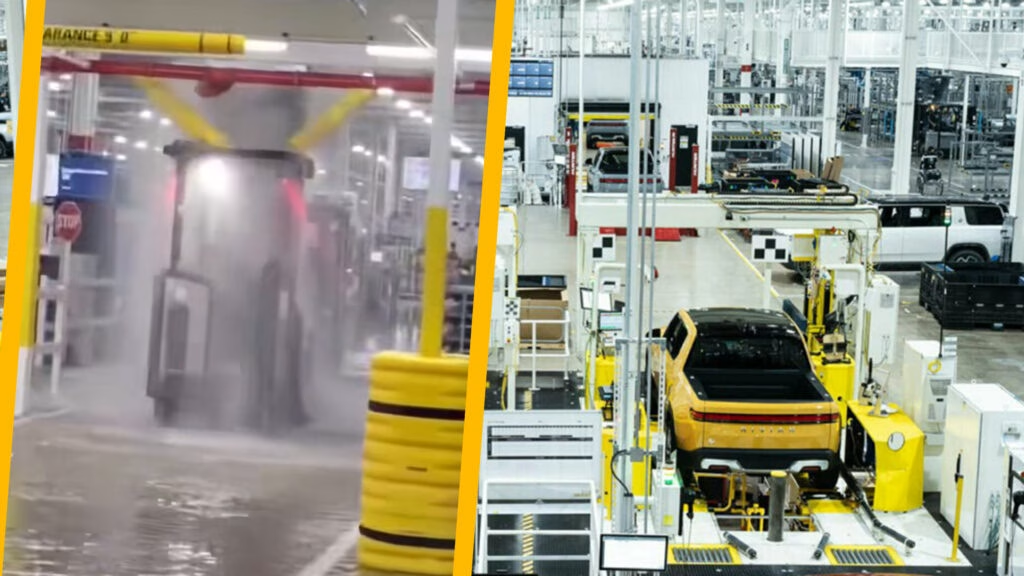How Did a Forklift Accident Lead to a Massive Flood at Rivian’s Factory?
Sometimes, the smallest missteps can cause the biggest headaches. At Rivian’s Normal, Illinois factory, a routine day took a wild turn when a forklift operator accidentally smashed into an overhead water pipe. Security footage later revealed the moment: the forklift, reversing along the production line, was just a bit too tall. The result? Pure chaos. Water gushed from the ruptured pipe, flooding the factory floor and halting production in its tracks.
The operator, who later shared his story on TikTok under the handle deryiooo, admitted to being distracted—listening to music through headphones and, shockingly, under the influence. That combination proved costly, both for him and for Rivian.
What Was the Real Cost of the Flood for Rivian?
You might think a little water wouldn’t do much harm in a giant auto plant. Think again. According to the former employee, the flood racked up a jaw-dropping $457,345 in damages. That’s not just a wet floor—that’s ruined equipment, interrupted workflows, and a whole lot of overtime for cleanup crews. For context, the National Safety Council estimates that the average cost of a workplace injury in the US is around $44,000, but major property damage incidents like this can easily soar into six figures.
The financial hit wasn’t just about replacing parts or mopping up water. Assembly lines had to be stopped, and other employees were pulled from their regular duties to help with the mess. In manufacturing, every minute of downtime is expensive. According to a 2023 report from the International Society of Automation, unplanned downtime can cost large manufacturers as much as $260,000 per hour. Even a brief stoppage can ripple through the entire operation.
Why Wasn’t the Employee Fired Immediately?
Here’s where things get interesting. Despite the scale of the accident, the forklift operator wasn’t shown the door right away. He was required to file an incident report and continued working for several months. Only later—after the story gained traction online—did Rivian let him go. Around the same time, he received a letter detailing the full extent of the damages.
This delayed response raises questions about workplace culture and accountability. Was Rivian hoping to handle things quietly? Or did they want to avoid drawing attention to a preventable safety lapse? Either way, the incident highlights the tricky balance companies face between transparency, discipline, and employee privacy.
What Does This Say About Safety Culture at Rivian?
This wasn’t the first time something like this happened at the plant, according to online commenters. Some claim similar accidents have occurred two or three times before, particularly in the battery department. While these reports are unverified, they point to a broader issue: safety protocols may not be as robust as they should be.
A 2024 investigation by ProPublica found that fast-growing EV manufacturers sometimes struggle to keep pace with safety standards as they ramp up production. When deadlines loom and pressure mounts, shortcuts can creep in. In Rivian’s case, the use of headphones on the factory floor and alleged substance use suggest gaps in enforcement and training.
What Can Other Manufacturers Learn from This Incident?
There’s a lesson here for every company with a bustling production line. First, clear communication and strict adherence to safety protocols are non-negotiable. The Occupational Safety and Health Administration (OSHA) has long warned about the dangers of distracted driving and equipment operation in industrial settings. Headphones, for instance, are generally prohibited in active work zones for exactly this reason.
Second, incident response matters. How a company handles accidents—both internally and in the public eye—shapes its reputation and employee morale. Prompt, transparent action not only prevents repeat mistakes but also builds trust with workers and the wider community.
Finally, investing in ongoing training and regular safety audits pays off. According to the Bureau of Labor Statistics, companies that prioritize safety see fewer accidents and lower overall costs. It’s not just about avoiding disasters; it’s about creating a culture where everyone looks out for each other.
How Did Social Media Play a Role in the Fallout?
The viral TikTok videos added a whole new twist. By sharing his story publicly, the operator put Rivian in the spotlight, forcing the company to address the incident more directly than it might have otherwise. Social media can be a double-edged sword for employers: it gives workers a voice, but it also means mistakes can go global in minutes.
For companies, this underscores the importance of clear social media policies and open internal communication. Employees need to feel heard and supported—before they turn to the internet to air their grievances or share their side of the story.
What’s the Big Takeaway for Anyone Working in Manufacturing?
Accidents happen. But in high-stakes environments like auto manufacturing, the margin for error is razor-thin. The Rivian flood wasn’t just about one distracted operator—it was a wake-up call about the importance of vigilance, training, and a safety-first mindset.
The big takeaway? Workplace safety isn’t about perfection—it’s about smarter adjustments. Start with one change this week, and you’ll likely spot the difference by month’s end.

